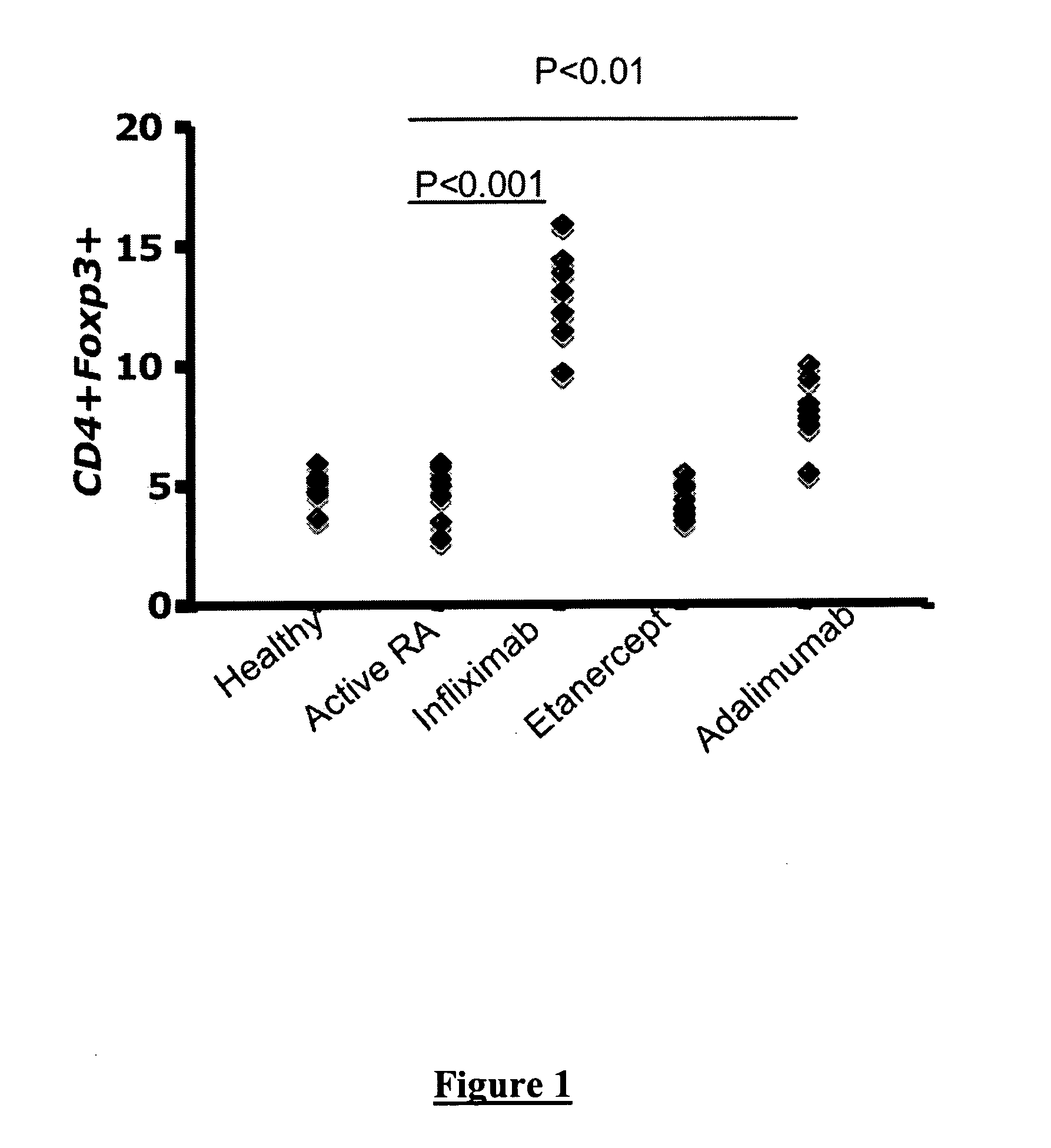Method for Predicting the Response of a Patient to Treatment with an Anti-TNF Alpha Antibody
a technology of alpha antibody and patient, applied in the field of predicting the response of a patient to treatment with an antitnf alpha antibody, can solve the problems of the immune response against the organism, achieve the effects of restoring the suppressive function, reducing the suppressive capacity, and restoring the defect of the immune respons
- Summary
- Abstract
- Description
- Claims
- Application Information
AI Technical Summary
Benefits of technology
Problems solved by technology
Method used
Image
Examples
example 1
In Vivo Methods
Materials and Methods
Study Population.
[0085]Twenty seven patients with active rheumatoid arthritis (RA), fulfilling the revised classification criteria of the American College of Rheumatology for RA were evaluated before and after anti-TNFα therapy (Infliximab given at a dose of 3 mg / kg i.v. at week 0, week 2, week 6, and then at every 8 weeks in combination with stable doses of methotrexate 7.5-15 mg / week orally) and stable non-steroidal anti-inflammatory drugs (NSAIDs). Patients taking prednisolone were excluded from the study since steroids are known to affect lymphocyte function and CD25 expression. Only patients with a disease activity score (DAS) of greater than 5.1 were treated with anti-TNFα therapy. Response was defined as a drop in the DAS of greater than 1.2. Patients who were responding to conventional dosages of methotrexate (15-25 mg / week) were also included in this study.
Antibodies.
[0086]The following antibodies were used: FITC conjugated anti-CD4 (RPAT...
example 2
Treg in RA Patients
Materials and Methods
[0091]31 patients with active RA, fulfilling the revised classification criteria of the American College of Rheumatology for RA were evaluated before and 4-6 months after anti-TNFα therapy. 20 Healthy individuals were used as controls. This study was approved by the UCLH Ethics Committee.
Antibodies.
[0092]The following Abs were used: FITC-anti-CD4 (RPA-T4), PE-Cy5-anti-CD25 (M-A251), PE-anti-CD62L (Dreg-56), PE-Cy7-anti-TNF-α (Mab11), PE-Cy7-anti-IFN-γ (45.B3), PE-FoxP3 (PCH-101), APC-anti-CCR7 (3D12), PE-anti-CD45RO (UCLH1). T cells were activated with soluble anti-CD3 (HIT-3a) and anti-CD28 (CD28.2) as indicated. All antibodies were from BD Bioscience (except FoxP3, from eBiosciences). For neutralisation experiments, anti-TGF-β1 (9016.2) and anti-human IL-10 (25209) were used (R&D systems). Infliximab, a chimeric IgG1 anti-TNFα monoclonal antibody, was donated by Schering Plough.
Cell Isolation.
[0093]Human blood mononuclear ...
example 3
Patient Selection
[0106]50 patients with rheumatoid arthritis (RA), who are to begin anti-TNFα therapy (including infliximab and etanercept) in the Bloomsbury Rheumatology Unit's New Therapies Clinic are recruited to the study. RA patients to be studied fulfil British Society of Rheumatology (BSR) eligibility criteria for the introduction of biologic therapies, with a Disease Activity Score (DAS) of >5.1, seropositive for anti-cyclic citrullinated peptide (CCP) and / or rheumatoid factor (RF). Response to therapy in RA patients is defined using criteria established by the European League Against Rheumatism measured measured twice at 3-5 months (DAS is also used as a continuous variable to assess response). The change in CRP is also documented. Blood samples are taken before therapy, and then 2, 8 weeks and 4 months following therapy (blood taken on no more than 4 occasions from individual patients).
[0107]A group of patients with psoriatic arthritis (periphera...
PUM
| Property | Measurement | Unit |
|---|---|---|
| molecular weight | aaaaa | aaaaa |
| permeability | aaaaa | aaaaa |
| adhesion | aaaaa | aaaaa |
Abstract
Description
Claims
Application Information
 Login to View More
Login to View More - R&D
- Intellectual Property
- Life Sciences
- Materials
- Tech Scout
- Unparalleled Data Quality
- Higher Quality Content
- 60% Fewer Hallucinations
Browse by: Latest US Patents, China's latest patents, Technical Efficacy Thesaurus, Application Domain, Technology Topic, Popular Technical Reports.
© 2025 PatSnap. All rights reserved.Legal|Privacy policy|Modern Slavery Act Transparency Statement|Sitemap|About US| Contact US: help@patsnap.com

